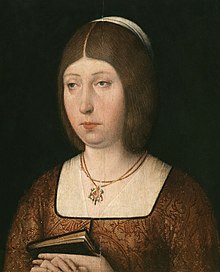
Back Isabella I. (Kastilien) ALS Isabel I de Castiella AN إيزابيلا الأولى ملكة قشتالة Arabic ايزابيل الاولانيه ملكة كاستييا ARZ Sabela I de Castiella AST I İzabella (Kastiliya kraliçası) Azerbaijani بیرینجی ایزابلای (کاستیا) AZB Isabella I kan Castile BCL Ізабела I Byelorussian Ізабэла I BE-X-OLD
| Isabella I | |
|---|---|
| Catholic Queen of the Spains[a] | |
 Anonymous portrait of Isabella I, c. 1490 | |
| Queen of Castile and León | |
| Reign | 11 December 1474 – 26 November 1504 |
| Coronation | 13 December 1474[1] |
| Predecessor | Henry IV |
| Successor | Joanna I |
| Co-monarch | Ferdinand V (from 1475) |
| Queen consort of Aragon | |
| Tenure | 20 January 1479 – 26 November 1504 |
| Predecessor | Juana Enríquez |
| Successor | Germana de Foix |
| Born | 22 April 1451 Madrigal de las Altas Torres, Ávila, Castile |
| Died | 26 November 1504 (aged 53) Medina del Campo, Valladolid, Castile |
| Burial | Royal Chapel of Granada, Andalusia, Spain |
| Spouse | |
| Issue more... | |
| House | Trastámara |
| Father | John II of Castile |
| Mother | Isabella of Portugal |
| Religion | Roman Catholicism |
| Signature | |
Isabella I (Spanish: Isabel I; 22 April 1451 – 26 November 1504),[2] also called Isabella the Catholic (Spanish: Isabel la Católica), was Queen of Castile and León from 1474 until her death in 1504. She was also Queen of Aragon from 1479 until her death as the wife of King Ferdinand II. Reigning together over a dynastically unified Spain, Isabella and Ferdinand are known as the Catholic Monarchs.[3]
After a struggle to claim the throne, Isabella reorganized the governmental system, brought the crime rate down, and unburdened the kingdom of the debt which her half-brother King Henry IV had left behind. Isabella's marriage to Ferdinand in 1469 created the basis of the de facto unification of Spain. Her reforms and those she made with her husband had an influence that extended well beyond the borders of their united kingdoms.[4]
Isabella I of Castile and Ferdinand II of Aragon are known for being the first monarchs to be referred to as the "Queen of Spain" and "King of Spain", respectively. Their actions included completion of the Reconquista, the Alhambra Decree which ordered the mass expulsion of Jews from Spain, initiating the Spanish Inquisition, financing Christopher Columbus's 1492 voyage to the New World, and establishing the Spanish empire, making Spain a major power in Europe and the world and ultimately ushering in the Spanish Golden Age.[5]
Together with her husband, Isabella was granted the title of "Catholic Monarch" by the Spanish Pope Alexander VI. Her sainthood cause was opened in 1974, granting her the title Servant of God in the Catholic Church.
Cite error: There are <ref group=lower-alpha> tags or {{efn}} templates on this page, but the references will not show without a {{reflist|group=lower-alpha}} template or {{notelist}} template (see the help page).
- ^ Gristwood, Sarah (2019). Game of Queens: The Women Who Made Sixteenth-Century Europe. Basic Books. p. 30. ISBN 9780465096794.
- ^ "To seize power in Spain, Queen Isabella had to play it smart". History Magazine. 28 March 2019. Archived from the original on 1 October 2019. Retrieved 8 February 2021.
- ^ Watson, Fiona Flores (26 July 2013). "History – The Catholic Monarchs". Andalucia.com. Retrieved 8 February 2021.
- ^ Highfield, J.R.L. "Isabella I | Biography, Reign, & Facts". Britannica. Retrieved 10 March 2023.
- ^ Palos, Joan-Lluís (28 March 2019). "To seize power in Spain, Queen Isabella had to play it smart: Bold, strategic, and steady, Isabella of Castile navigated an unlikely rise to the throne and ushered in a golden age for Spain". National Geographic History Magazine. Archived from the original on 30 March 2019. Retrieved 20 April 2019.